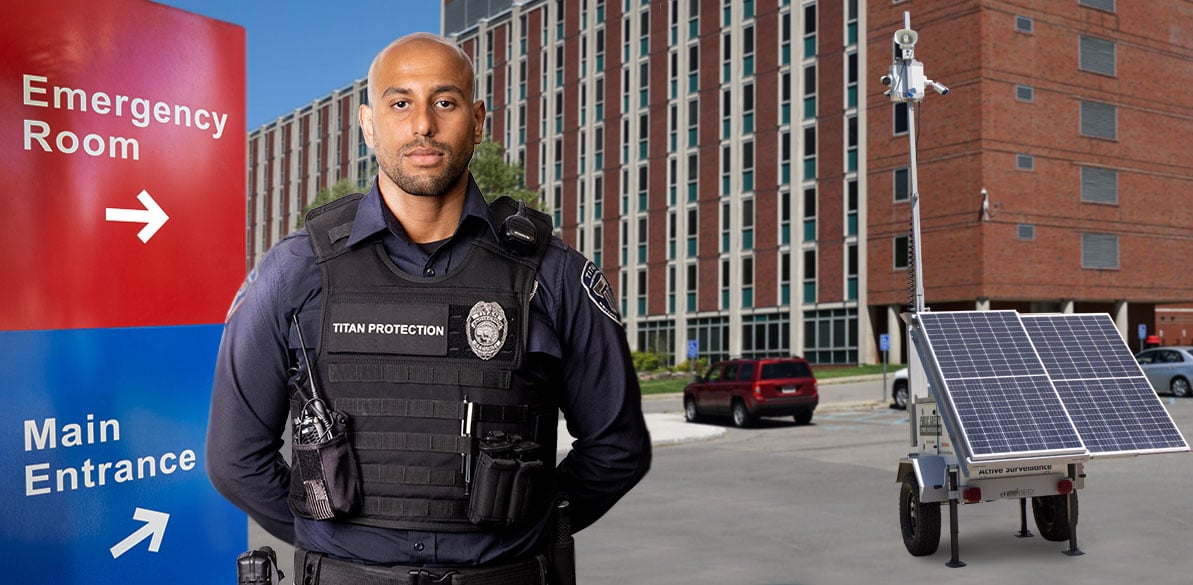Hospital Security and Perimeter Protection: A Blended Approach

- Virtual Guard,
- Hospital Security
Hospital security is essential for protecting patients, staff, and visitors against growing threats like trespassing, violence, and theft. By combining physical patrols with virtual surveillance, hospitals can implement a layered, multi-zone security strategy that keeps every area—from parking lots to emergency rooms—safe and controlled.
Why Hospital Security Requires a Blended Approach
Hospital security is more critical than ever due to increasing incidents of trespassing, violence, and theft in healthcare facilities. With hospitals operating 24/7 and dealing with high foot traffic, a single weak point in security can put patients, staff, and visitors at risk.
A blended security strategy using physical and virtual security is essential for safeguarding different areas of a hospital, from the perimeter to emergency rooms and parking areas. By implementing this specialized approach, hospitals can enhance safety, prevent unauthorized entry, and maintain a secure environment for all.
Perimeter Security: The First Line of Defense
The hospital perimeter is the first barrier against external threats, including trespassing, loitering, and unauthorized vehicle access. A well-secured perimeter prevents potential security risks before they reach the hospital’s main building.
Security guards play a vital role in:
- Monitoring entry points to restrict unauthorized access
- Patrolling parking lots to deter suspicious activity
- Enforcing restricted access to safeguard hospital grounds
Titan’s Virtual Officers (VOs) compliment your on-site guards with an added layer of perimeter protection. VOs use live video surveillance to monitor hospital entrances, exits, and outdoor areas in real time—identifying possible suspicious activity, alerting security teams, and even communicating directly with individuals on hospital grounds via two-way audio. This blended approach enhances perimeter coverage while keeping costs efficient.
Zone-by-Zone Security Strategies
But a hospital’s security needs extend beyond just the perimeter—each zone presents unique challenges that require specialized protection. From high-risk emergency rooms to busy visitor areas and vulnerable parking lots, security guards and technology both play a critical role in maintaining safety across all hospital spaces.
Emergency Room (ER) Security
The ER presents unique challenges due to its high-stress environment. Security risks include:
-
- Aggressive behavior from patients or visitors
- Late-night incidents involving aggravated or violent individuals
- Overcrowding and long-waits that can lead to conflicts
Security guards help maintain a safe environment by:
-
- Managing ER access to keep unauthorized individuals out
- Supporting medical staff in handling emergency situations
- De-escalating conflicts to prevent violence
Visitor Access Control & ID Verification
Hospitals must ensure that only authorized individuals enter restricted areas. Security guards assist by:
-
- Checking IDs and enforcing visitor badge policies
- Monitoring visitor flow to prevent unauthorized entry
- Enforcing after-hours restrictions to enhance safety
Parking Lot Security
Safety risks in healthcare settings can also happen outdoors. Hospital parking lots are high-risk areas for crime, including:
-
- Vehicle theft and vandalism
- Assaults and loitering
- Unattended individuals creating security risks
Security guards can help mitigate these threats by:
-
- Patrolling parking lots to deter crime
- Escorting staff and visitors when needed
- Monitoring surveillance feeds to detect suspicious activity
For extended visibility across parking areas and campus-style healthcare facilities, Titan’s Virtual Officers can remotely monitor live camera feeds to help deter loitering and guide emergency response. In addition, drone security can provide offer dynamic and cost-efficient surveillance of hospital parking lots and external spaces—especially useful for university hospitals or large multi-building complexes.
This bird’s-eye view allows security teams to detect threats and coordinate response faster than traditional foot patrols alone.
Implementing a Multi-Zone Security Strategy
To establish a layered security approach, hospitals should:
- Assess security vulnerabilities across all zones
- Deploy professional security teams rather than relying solely on in-house staff
- Implement access control measures such as visitor ID verification
- Use surveillance and patrols for continuous monitoring
- Integrate advanced technologies like virtual officers and drones to supplement on-site teams and expand coverage across campuses and hard-to-reach areas
Partner with Titan for Comprehensive Hospital Security
Titan Protection offers superior security solutions for healthcare facilities that integrate professional, on-site security teams with the most advanced technology for a seamless, multi-zone approach.
Need assistance with developing a healthcare security program? Contact Titan Protection today. Simply fill out the form below and a Titan team member will help find the right security plan for you.
Subscribe To Email Update
Posts by Topic
- Video Monitoring
- Drone Security
- Virtual Guard
- Construction Site Security
- Auto Dealership Security
- News
- Commercial Property Security
- Parking Lot Security
- Press Release
- blended Security
- Cannabis Dispensary Security
- Hospital Security
- Kansas City
- Campus Security
- Critical Facility Security
- Data Center Security
- Events
- St. Louis Security
